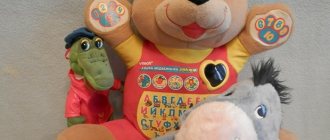Development of imagination in preschool children. It is impossible to imagine a child without imagination. The world of children differs significantly from that of adults because children are capable of inventing and thinking outside the box. The ability to imagine helps develop creative abilities, find ways out of difficult situations, and it is easier to adapt in real life if you direct your imagination in the right direction.
Features of the development of creative imagination in a preschool child
The baby takes his first steps towards the ability to use his imagination at the age of three. Play becomes part of the child, wherever he is: at home, on a walk, visiting, on a trip. During this period, the child begins to understand that one and the same object can play the role of several, if you use your imagination. Three- and four-year-old children begin to tell fairy tales - this awakens their previously dormant imagination. But they don't know how to plan. It is difficult to find out from such a child what he is going to draw if the child took pencils and paper. With the help of imagination, the drawing, of course, will be born, but the image of the future “picture” will be built in the process.
Until the age of five, preschool children still do not know how to direct their imagination, but at five or six years old they are already good inventors who can consciously decide what they want to play, what they need to draw, what craft they want to make. Once the goal is set, the work begins. Often, in play, children try to embody the experience they have gained, their impressions of watching a cartoon or a play, or some life scene.
Often children create their own special world if something in the real world does not suit them: difficult relationships with peers or adults, including parents; phobias that the child tries to fight in a self-invented way; problems that are easier to solve in a fantasy world.
In any case, the development of imagination is very important for a child. This is one of the levers with which a little person learns to interact with the world.
Children's imagination and the importance of its development
The ability to imagine and imagine is formed on the basis of activity. Playing, drawing, modeling are based on the fact that you need to depict something or someone.
Imagination as a mental process consists in transferring the function of one object to another, in the ability to imagine a holistic image, relying on a limited number of details.
The imagination of a preschooler differs from the same function in an adult. This is due to the smaller number of frames that are imposed on fantasy in preschool age.
The peculiarities of a preschooler's imagination are that it is easy for a child to move away from reality in order to explain an incomprehensible fact or phenomenon. This is the cement that fills the gaps in knowledge that still exist and helps to better understand the world. If a preschooler has already heard that astronauts fly in a rocket, then he will be interested in the flight itself. How the space flight goes will be completed by your imagination.
By imagining, children expand the boundaries of their own existence. A child can become a pirate, a beautiful princess, attend a ball or endure a catastrophic storm. He does not care whether this actually happens, but is fascinated by the process of fantasy. Even fictional experiences enrich the moral and emotional experience.
On the other hand, preschoolers' fictional images are rather schematic and stereotypical. They endow imaginary characters with typical traits borrowed from familiar stories and fairy tales. The development of imagination in children requires filling the imaginative reserve and mastering new ways of transforming material and impressions.
Types of imagination
Experts distinguish several types of imagination.
Creative
Human consciousness allows you to compose incredible images, without relying on knowledge and experience. Such imagination, with its further development, can even become the basis for a person’s future profession related to writing.
Recreating
This type of imagination is based on existing knowledge; images that the child became acquainted with in classes, in communication with relatives and friends appear from memory and are developed.
Wild fantasy
Uncontrolled imagination, where reality and fantasy replace each other. The child constantly thinks about something and declares that all this actually happened.
Methods and techniques for developing imagination in preschool children
Since healthy imagination is important for the harmonious development of a child, adults should help develop this imagination correctly.
There are several effective techniques. They are based on the development of the child’s creative abilities, as well as his mental activity.
This:
- Applied activities,
- Literature classes,
- Didactic games,
- Development of horizons,
- Development of tactile abilities,
- Art, music, dance classes.
Applied activities are one of the methods not only to awaken a child’s imagination, but also to direct him in the right direction. So, drawing or modeling classes will help teach your child to come up with and implement an idea. Construction will make it possible to create something fantasy, but this object can already be touched, it can become the object of games. Let the child come up with things that do not exist in the real world, but this is much more interesting. A fictional thing may have characteristics that the author himself gives it.
A good option to develop imagination is fairy tales that the child himself composes. An adult just needs to help, give a start to imagination. Let this be a simple story, the very beginning. And only then the child must figure out what will happen to the characters next, what adventures await them. And if a child comes up with a fairy tale and draws at the same time, clearly showing the plot, even better.
Didactic games play a great role in the development of imagination. An experienced teacher can interest a child by inviting him to study and play at the same time.
So, you can use the following techniques.
Types and functions of a child’s imagination
In psychology, a distinction is made between cognitive and emotional childhood imagination. The emotional is aimed at regulating the feelings experienced and the formation of the personal Self, and the cognitive contributes to the understanding of the surrounding reality. Both types are involved involuntarily in early preschool age. Only by the age of 6 does a child learn to deliberately come up with a plan in order to consistently implement it.
Involuntary
Adults are often amazed at children's free imaginations and are puzzled why the child cannot or does not want to fantasize on a given topic. But before the age of 5, the reasons are exclusively objective - the youngest preschooler does not yet know how to control his imagination.
Involuntary imagination is characterized by the fact that the idea arises spontaneously and is associated with objects, stories or incidents that surprised and excited the child. It could be a fairy tale story or a cartoon character, a bright toy or an unusual event.
Imagination seems to lead the child’s thoughts along with it, giving him ideas for creating an image. Its main feature in early preschool age is the lack of control over the process.
free
Elements of arbitrariness appear upon reaching the age of five. Voluntary imagination is also called active imagination. Often the trigger is the task at hand: for example, performing the actions of your hero in role-playing games. To portray a cowboy, an astronaut or Malvina, the imagination has to work in full force - after all, the role must be depicted as accurately as possible.
You should not wait for a preschooler to awaken the ability to purposefully use his imagination. The adult’s task is to encourage the child to come up with images. You can remember and discuss a children's work together, pay attention to individual characters, and consider options for creating an image.
Within the framework of arbitrary imagination, there are 3 types:
- Recreating - the task is to imagine the child followed by a description of an object or item that he did not see. Example: a non-existent animal, a resident of Mars or the Moon.
- Creative imagination - a preschooler creates new images based on personal perception, moving away from known patterns and pushing boundaries.
- Dreams - from a child’s fantasies of what he will receive for his birthday to ideas of what he will become when he grows up.
Cognitive function
Imagination performs two important functions. Cognitive ensures the elimination of “blind spots”. A child’s mind has already formed a certain idea of the world around him, but many gaps have not yet been filled. The ability to operate with images “fills” these spots and helps to obtain yet unknown impressions.
In addition, imagination helps explain the meaning of a person’s actions if, due to his age, the baby does not understand why someone is crying, laughing or doing something incomprehensible.
The older the preschooler, the more he takes into account natural patterns in his fantasies. It is important for him to come up with images in which, along with fantastic qualities, there would be real characteristics.
Affective function
The affective function of the preschooler’s imagination is aimed at upholding and protecting one’s own self. The relationship between anxiety and imagination helps to avoid injury.
Emotional fixation on certain experiences unconsciously pushes the child to simulate a situation that is significant to him in one of the ways known to him:
1. An impact or situation that has a negative impact on the psyche is repeatedly played out. Numerous repetitions help to distance yourself from the event itself and turn from a participant into an observer.
2. If necessary, the child creates situations in which he feels like a hero. He puts himself in the shoes of numerous superheroes and saves worlds with a sense of agility, courage and power. Frequent repetitions of situations with victories and successes help a preschooler increase self-esteem.
Developing imagination through non-traditional drawing
Unconventional drawing methods are unusual, interesting and useful. The child learns to see the miraculous in the most ordinary things. So, he learns that, it turns out, you can draw, for example, with your palms, a comb and a sponge, and not with a brush, with biscuit cream, and not just with paints. This awakens the imagination, the child has a desire to try new and unknown things.
Here are the simplest ways to draw unconventionally:
- Drawing with a candle.
- Drawing with splashes through a straw.
- Drawing with stamps made from bottle caps, sponges, chewed paper.
- Finger painting.
- Isothread: the thread is dipped into the paint, pressed against the paper, and the resulting print can be expanded into a real design.
- Drawing with a comb.
- Drawing with a cotton swab.
- Children of any development will enjoy drawing this way. Moreover, some methods help in the prevention of certain diseases, as well as in the correction of speech, breathing, and vision.
The influence of fairy tales on the development of a preschooler’s imagination
A fairy tale is the main tool for developing imagination. Thousands of imaginary magical stories trigger mental processes that allow you to create new images and expand the boundaries of existing reality. A fairy tale can be compared to instructions in colorful packaging. By listening and retelling, children receive ready-made examples, as well as new ideas and means for imagination.
Development of imaginative thinking and fantasy
To develop imaginative thinking and imagination, just listening to a fairy tale is not enough.
Although children with particularly developed imaginations automatically begin to develop the story.
An effective method is games with the task: “What would happen if...”
In such exercises, children, based on an existing plot, learn to come up with new developments of events and whole series of stories that are distinguished by their originality, although initially the bun simply ran away from their grandmother and was eaten by a sly fox.
The formation of a child’s affective imagination
The affective function of the imagination is aimed at the need to protect oneself from the traumatic facts of reality. In this case, the fairy tale performs important functions:
- The opportunity to immerse yourself in history, distracting yourself from real events and putting yourself in the place of the main and successful hero;
- A magical story with a similar plot allows you to turn into an observer and adopt some ways of behavior and expression of emotions. For example, the story of Cinderella can help cope with a similar situation in the family.
- An opportunity to experience feelings of fear or guilt in a safe environment while listening to and discussing a fairy tale story.
The instructive meaning of fascinating fairy tales is a valid example to follow. Researchers have already proven that if you tell children two different examples - successful and unsuccessful - then almost every child will prefer to use the successful one. This fact further enhances the value of fairy tales in the development of a preschooler.
Using various techniques to develop imagination in preschoolers, educators and parents promote the harmonious development of the individual and simplify the process of current and subsequent adaptation in society.
Development of imagination by means of construction
There are many construction sets on sale that both children and adults enjoy playing with. Of course, there is no need to set complex design tasks for the child. But construction kits with proposed assembly schemes can be the start of an interesting hobby for a child. And if an adult gets involved in the design, then the design itself can turn into a game.
Design helps:
- develop spatial imagination,
- gain knowledge about shape, size, the first rudiments of knowledge about geometry,
- develop fine motor skills, which is useful for the development of thinking,
- develop independence, perseverance,
- develop imagination.
It will be useful for preschoolers to play with cubes, which will allow them to get a first idea of shape, color, size; mosaic, which teaches you to pay attention to little things; block constructors that create three-dimensional objects for games; Lego, with the help of which children become acquainted with 3D modeling skills.
Imagination disorders and their causes
Children may suffer from a lack of imagination or, on the contrary, their imagination becomes uncontrollable.
Imagination deficits are usually experienced by children with speech impairments, because speech and thinking and imagination are interconnected. With speech pathology, the child thinks primitively, he is not able to create a new image, he cannot invent, compose, and also carry out tasks of an adult where he needs to use his imagination. These children usually have difficulty remembering terms, assimilating the acquired knowledge, and do not understand symbols.
Children who have low self-esteem may also have a deficit of imagination. They are afraid of doing something wrong, they are absolutely deprived of independence, which suppresses imagination.
In this case, teachers need to creatively overcome the child’s inhibition step by step, offering to develop abilities through play, the basis of which will be a situation familiar to the child. A good way out of this situation would be the theater. You also need to focus on cognitive activities to broaden the child’s horizons. Emphasis on emotions will play a big role. What impressed you will leave a mark on your soul, and you will want to learn more about it.
Violent fantasy, which can manifest itself in aggression, lies, fears, and the replacement of the real world with a fantasy world, can also interfere with the normal productive development of the imagination.
The reasons for this inadequate imagination may be the child’s internal fears, problems he has with family and peers, inability to get along with the outside world, as well as other psychological problems.
In this case, it is advisable to contact psychologists who will help create an individual program to eliminate the pathology.
Features of imagination in older preschool age.
Senior preschool age is sensitive (sensitive) for the formation of imagination. Let us consider the features of the development of imagination in children of senior preschool age, which were identified by psychologists L.S. Vygotsky, V.V. Davydov and D.B. Elkonin.
L.S. Vygotsky characterizes senior preschool age by activating the function of imagination: first, recreating imagination - which allows one to imagine fairy-tale images at an early stage, and then creative imagination - thanks to which a fundamentally new image is created. V.V. Davydov points out such a feature of the imagination of older preschoolers as the mobility of imaginative images, the ability to deviate from a stereotyped, hackneyed solution; creation of a new, original work; coming up with different versions of the same topic. These features determine the level of creative imagination. The images and ideas of preschool children are flexible and dynamic, which allows a child of senior preschool age to isolate different properties of these images, transfer them to other images, and create new images, wrote V.V. Davydov. D.B. Elkonin argues that the development of children’s imagination is associated, first of all, with special visual-figurative tasks, the conditions of which are set from the outside, and the grounds and purpose of such tasks are associated with understanding their conditions. At the age of five, children begin to have dreams about the future. They are situational, often unstable, caused by events that caused an emotional response in children. The support is not only the real object, but also the ideas expressed in the word. The child begins to compose fairy tales, reversals, and continuing stories. However, the preschooler's imagination remains largely involuntary. The subject of fantasy becomes something that greatly excited, fascinated, or amazed him: a book he read, a cartoon he saw, or a new toy. The growth of the arbitrariness of the imagination is manifested in the development of the ability to create a plan and plan its achievement. Older preschoolers are able to fantasize freely, planning in advance the process of implementing the idea. They outline a plan to achieve the goal and pre-select ready-made equipment.
Features of the development of children of senior preschool age, first of all, are manifested in the intensive development of thinking and other intellectual processes, a significant change in the motivational sphere, and orientation towards social relationships in the adult world. Many psychologists believe that it is at this age that the problem of developing imagination should come to the fore in raising a child. The bearer of social experience for a child is an adult. The interaction between a child and an adult gives rise to certain forms of mental activity. Author of the psychological and pedagogical theory of amplification and enrichment of development A.V. Zaporozhets emphasizes the enormous importance and intrinsic value of specifically “children’s” types of activities and forms of communication. It is becoming urgent to search for new sources of enriching the content of children’s activities and, in this regard, to study the influence of games on the development of imagination precisely in older preschool age. The prerequisites for the development of imagination are the child’s activity, his need for new experiences, communication and self-affirmation. The sources of imagination formation are the joint actions of an adult and a child to recombine the subject environment, giving unusual meanings to an object, the creation by an adult of imaginary situations with the participation of a child, verbal communication, verbal and figurative interpretation by an adult of the child’s sensory experience.
In studies of specific types of creative activity of preschoolers, the development of imagination is considered as its transition from recreating forms to more creative ones. The authors consider 2.5 - 4 years to be the lower limit of imagination. It is traditional and generally accepted that the imagination develops by the age of 3-4 at the level of developed speech in the process of role-playing play, when the child creates a detailed imaginary situation (L.S. Vygotsky, S.L. Rubinstein, A.N. Leontyev, D. B. Elkonin, V. V. Davydov, etc.). Imagination is an element of the symbolic function and is formed together with speech in the joint actions of a child and an adult according to the mechanism of social inheritance. The most important moment of imagination is the creation (vision) of a complete image before its parts.
Older preschool age (5-6 years) is considered by some psychologists and teachers as the time of formation of productive activity, when the development of imagination depends on the specific content of actions. It is possible to assume that the general mechanisms of imagination develop within these time boundaries. As soon as a child begins to walk and gains free access to objects, his desire to change the subject environment and vary his actions is observed. Objects are carried, rearranged by the child, connected, used by him in different conditions and with different meanings. Recombining the subject environment is accompanied by bright positive emotions. The child admires the result, claps his hands, and invites everyone to watch. All this allows us to characterize variable actions as the prehistory of the game, and the methods of their implementation as materialized forms of imagination: separation-connection, transfer to other conditions, animation, attributing the functions of one object to another. The motive is getting new experiences and the joy of creating them yourself. They express a personal element—the child’s playful attitude toward the subject.
As the child masters phrasal speech, he begins to use words to complete the image of an event based on its individual elements. Stories appear - interpretations about drawings, cartoons, vaguely perceived objects, individual sounds. In the 3rd year of life, the mechanisms and methods of recombining experience are improved. The variation in the arrangement of objects decreases, the variation in the methods of action increases. The child includes elements of the imaginary into everyday actions: “Let the doll watch what I do.” The plots of the game, the characteristics of the characters, and the position of the toys vary. The conditioned action begins to achieve high schematization - it is performed on any object and even without objects based on the word (they treat them with milk out of nothing). Imaginary situations are expressed in words, bright and varied. The game develops in the logic of action (a detailed plot) and in the logic of the image - the plot is colored by facial expressions, emotions, and accompanying actions. Speech-story is still accompanied by conditional actions, but actions are increasingly described in words. At the same time, the images become variable and endowed with unusual properties (good fox, good wolf, etc.). Specific phenomena of the imagination appear: personal inclusions in the plot, one’s own endings and versions of fairy tales, fantasy lies, fears, the ideal image of a good child, distant intentions (“When I grow up...”).
At the age of 3 to 5 years, material recombination actions are increasingly replaced by verbal ones. The child begins to “figure out” and “try on” options, for example: “If there is blood, should I fill it with iodine? What if it’s a small wound?.. What if it’s tiny? What if there’s a lot of bleeding?” Variation becomes imaginary. Imaginary situations are dynamic and variable, which is achieved by verbal addition to the plot; the game lasts several days and includes stories about the characters' actions in the past. The plot is created easily; A short cue is enough, and the child enters the role. Vivid images encourage you to furnish the game with numerous attributes, to prefer detailed, realistic toys to conventional substitutes.
Ideas change significantly, the child operates with them freely. He adds a phrase or scene he hears to a complete image with a variety of elements involved (having seen in the cartoon that the king drowned, he adds: “But the queen waited and waited for him, but never came”). There is a peculiar game of transformation of images, such as: “If this ditch were wide, wide, then what would the street become?” The ability to imagine circumstances and correlate details reduces fantasy lies. Fears remain, but the child understands their groundlessness.
Personal inclusions in literary plots are associated with given circumstances: the child no longer changes events, but mourns the hero in a hopeless situation or says, “I wouldn’t do that.” Images - ideals also acquire a detailed character. In stories about a good doll, one hears a set of ideal qualities and actions; they reflect the child’s intentions, but not always real behavior. By the age of 5, the planning function of the imagination increases. When going out to play, they select toys for a specific plot. They represent a two-pronged development of the plot: you do this, and I will do this. The partner’s actions begin to be imagined several moves ahead. Real conditions for role-playing games are created. But in group play, detail and artistry decrease, children begin to act in an average way, “as it happens.” Imagination begins to serve productive activity. Items are tried on in advance for different functions and subjects. They begin to collect all sorts of wires and buttons for future use in the hope of attaching them to something. Intentions to draw this and that appear—preliminary actions on an imaginary plane. Technical fantasies (“To make the crib fly”) and object roles appear: I am a tractor, I am a puck, etc. The child tries to model technical devices using inadequate means—role. Bright, detailed images encourage drawing, but they also increase the criticality of self-esteem, which can discourage drawing for a long time.
In drawings and buildings, verbal additions are much richer than images. The above facts allow us to say that by the age of 4 the world of fantasy becomes isolated, and the child takes a detached position. Images become dynamic, change in changing circumstances, and are used to mentally “play out” real situations. At 5-6 years of age, the planning function of the imagination intensifies as preliminary preparation of means and “playing out” future actions.
In older preschool age, when performance in memorization appears, the imagination turns from reproductive (recreating) into creative. The imagination of children of this age is already connected with thinking and is included in the process of planning actions. Children's activities become conscious and purposeful. Children's creative imagination is manifested in role-playing games. By the end of the preschool period of childhood, children’s imagination is presented in two main forms:
arbitrary, independent generation of an idea by a child;
the emergence of an imaginary plan for its implementation.
Psychologists associate the emergence of voluntary imagination with the complication of children’s activities and communication. In particular, the first images of voluntary imagination are created by the child under the influence of the verbal influences of an adult in a role-playing game.
Let us highlight a few more features characteristic of the imagination of older preschoolers. In the process of creating creative images, children of senior preschool age use both a combination of previously received ideas (memory ideas) and their transformation, carried out by analyzing and synthesizing existing ideas and current perceptions. A widely used technique for creating creative images is hyperbole. Deliberately, sometimes grotesquely, exaggerating any qualities of objects or phenomena, taking them to the extreme, absolutizing them, children of senior preschool age create sharp opposites that are understandable. For example, in stories and fairy tales written by children, even the main characters are described without halftones or nuances. The main characters are either the embodiment of all negative qualities, or “angels in the flesh.” The animistic nature of the images created by children is also well known. Often in his imagination, a child endows inanimate objects with the attributes of a living thing, and gives anthropomorphic features to dead matter and physical phenomena.
Thinking by analogy reaches a high level of development. In terms of imagination, older preschoolers easily transfer the qualities of one object to another, and often resort to metaphors. Thus, the importance of imagination in mental development is great; it contributes to better knowledge of the world around us and the development of the child’s personality. So, after analyzing the features of the imagination of children of senior preschool age, we can draw the following conclusions.
So, the imagination of children of senior preschool age has the following distinctive features:
-in older preschool age, the formation of a special activity of the imagination occurs - fantasizing;
- the child masters techniques and means of creating new images;
- imagination acquires an arbitrary character, involving the creation of a plan, its planning and implementation;
-imagination moves to the internal plane, since there is no need for visual support for creating images.
What influences the development of a child’s imagination
In order for the development of a child’s imagination to proceed correctly, it is necessary to create a comfortable atmosphere in which the child will learn to fantasize with pleasure and benefit, but will not cross the dangerous line between reality and the illusory world.
- Develop speech, since thought processes are associated with speech functions.
- Pay attention to the development of the child's fine motor skills. The more actively a child works with his hands, the better he speaks and thinks.
- Eliminate loneliness, which, in turn, will eliminate the need for the child to create imaginary friends.
- It is important to increase a child’s self-esteem, not by comparing him with other peers, but by comparing him only with himself, based on his achievements and actions.
- Trusting relationships with parents play a big role. If a child is not afraid of punishment, then he will not have to lie. But you can encourage creative writing - fairy tales, stories, drawings, crafts.
- There should be a lot of creativity in a child's life. These activities stimulate the imagination.
- its prerequisites, representation and delayed imitation take shape;
- imagination appears in the game when an imaginary situation arises and game renaming of objects;
- imagination functions only with the support of real objects and external actions with them.
§ 2. Development of imagination in preschool age
The imagination of a preschooler differs from the imagination of an adult; behind its apparent wealth lies poverty, vagueness, sketchiness and stereotyping of images. After all, the basis of imaginative images is the recombination of material stored in memory. But preschoolers still have insufficient knowledge and ideas. The apparent wealth of imagination is associated with the low criticality of children's thinking, when children do not know how it happens and how it does not happen. The lack of such knowledge is both a disadvantage and an advantage of children's imagination. A preschooler easily combines different ideas and is uncritical of the resulting combinations, which is especially noticeable in early preschool age (L.S. Vygotsky).
A preschooler does not create anything fundamentally new from the point of view of social culture. The characterization of the novelty of images matters only for the child himself: whether this was the case in his own experience.
Until children reach the age of 5-6 years, almost throughout the entire preschool age, they lack a plan or it is extremely unstable and easily destroyed. And sometimes (especially at 3-4 years old) the idea is born only after the action. The child does not think about the possibilities of practical implementation of the images he creates. For an adult, a dream acts as a stimulus to action. But for a child, combinations of images are practically hopeless. He fantasizes for the sake of fantasizing. He is attracted by the very process of combining, creating new situations, characters, events, which has a strong emotional overtones.
At first, the imagination is inextricably linked with the object, which serves as an external support. So, in a game, a 3-4 year old child cannot imagine an action with an object. He cannot rename an item unless he acts on it. He imagines a chair as a ship or a cube as a saucepan when he works with them. The substitute item itself must be similar to the item being replaced. It is toys and objects-attributes that lead the child to one or another plot of the game (M.G. Vityaz). For example, I saw a white coat - I started playing hospital, I saw the scales - I became a “salesman”. If for younger preschoolers the support in play is toys, then for middle and older preschoolers it is the fulfillment of the role they have taken on. Gradually, the imagination begins to rely on objects that are not at all similar to those being replaced. Thus, older preschoolers use natural materials (leaves, cones, sticks, pebbles, etc.) as play materials.









